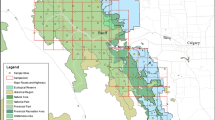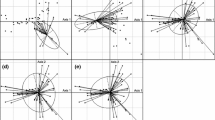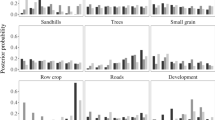Abstract
Context
Interspecific competition can limit species distributions unless competitors partition niche space to enable coexistence. Landscape heterogeneity can facilitate niche partitioning and enable coexistence, but land-use change is restructuring terrestrial ecosystems globally with unknown consequences for species interactions.
Objectives
We tested the relationship between landscape heterogeneity and carnivore co-occurrence in natural and human-dominated ecosystems to assess the landscape-mediated impacts of anthropogenic change on coexistence.
Methods
We used boosted regression trees to model the distributions and co-occurrence of two competing forest carnivores, American martens and fishers, at two contrasting sites in the Great Lakes region, USA: a “natural” site largely devoid of human impacts and a “human-dominated” site with substantial development and a history of land-use change. We assessed the importance of climate and habitat variables for each species, measured spatial niche overlap, and quantified co-occurrence as a function of compositional (patch richness), configurational (landscape shape), and topographical (elevation range) heterogeneity per site.
Results
We observed significant differences in the effect of heterogeneity on co-occurrence between sites. The natural landscape exhibited little niche overlap and co-occurrence had a significant, positive relationship with heterogeneity. Conversely, the human-dominated site exhibited high niche overlap with variable effects of heterogeneity on co-occurrence. Elevation, snowpack, and development had strong, contrasting effects on marten and fisher distributions, suggesting that differential use of habitat and anthropogenic features facilitates coexistence.
Conclusions
Heterogeneity can facilitate coexistence, but too much may undermine carnivore coexistence in human-dominated landscapes where habitat and space are limited. Moreover, future climate change will likely erode niche partitioning among martens and fishers, with particularly strong consequences for coexistence in human-dominated landscapes and at range boundaries.




Similar content being viewed by others
Data accessibility
All data is archived in FigShare (https://doi.org/10.6084/m9.figshare.12724667).
References
Amarasekare P (2003) Competitive coexistence in spatially structured environments: a synthesis. Ecol Lett 6:1109–1122
Bayne EM, Boutin S, Moses RA (2008) Ecological factors influencing the spatial pattern of Canada lynx relative to its southern range edge in Alberta, Canada. Can J Zool 86:1189–1197
Bowers MA, Brown JH (1982) Body size and coexistnce in desert rodents: chance or community structure? Ecology 63:391–400
Brown JH (1984) On the relationship between abundance and distribution of species. Am Nat 124:255–279
Buskirk S, Powell R (1994) Habitat ecology of fishers and American martens. In: Buskirk S, Harestad A, Raphael M, Powell R (eds) Martens, Sables, and Fishers: Biology and Conservation. Cornell University Press, Ithaca, New York, pp 283–296
Cardille JA, Lambois M (2010) From the redwood forest to the Gulf Stream waters: Human signature nearly ubiquitous in representative US landscapes. Front Ecol Environ 8:130–134
Carroll C (2007) Interacting effects of climate change, landscape conversion, and harvest on carnivore populations at the range margin: marten and lynx in the northern Appalachians. Conserv Biol 21:1092–1104
Channell R, Lomolino MV (2000) Dynamic biogeography and conservation of endangered species. Nature 403:84–86
Chapron G, Kaczensky P, Linnell JDC, von Arx M, Huber D, Andrén H, López-bao JV, Adamec M (2014) Recovery of large carnivores in Europe’s modern human-dominated landscapes. Science. https://doi.org/10.1126/science.1257553
Chase JM, Leibold MA (2003) Ecological niches: linking classical and contemporary approaches. University of Chicago Press
Chesson P (2000) Mechanisms of maintenance of species diversity. Annu Rev Ecol Syst 31:343–358
Cruz P, Iezzi ME, De Angelo C, Varela D, Di Bitetti MS, Paviolo A (2018) Effects of human impacts on habitat use, activity patterns and ecological relationships among medium and small felids of the Atlantic Forest. PLoS ONE 13:1–21
Darimont CT, Paquet PC, Reimchen TE (2009) Landscape heterogeneity and marine subsidy generate extensive intrapopulation niche diversity in a large terrestrial vertebrate. J Anim Ecol 78:126–133
Donadio E, Buskirk SW (2006) Diet, morphology, and interspecific killing in carnivora. Am Nat 167:524–536
Dumyahn J, Zollner P, Gilbert J (2007) Winter home-range characteristics of American marten (Martes americana) in northern Wisconsin. Am Midl Nat 158:382–394
Durant SM (1998) Competition refuges and coexistence: an example from Serengeti carnivores. J Anim Ecol 67:370–386
Elith J, Leathwick JR, Hastie T (2008) A working guide to boosted regression trees. J Anim Ecol 77:802–813
Erb J (2015) Furbearer winter track survey summary, 2015. Minnesota Department of Natural Resources, Forest Wildlife Research Group
Erlinge S, Sandell M (1988) Coexistence of stoat, Mustela erminea, and weasel, M. nivalis: social dominance, scent communication, reciprocal distribution. Oikos 53:242–246
Fisher JT, Anholt B, Bradbury S, Wheatley M, Volpe JP (2013) Spatial segregation of sympatric marten and fishers: the influence of landscapes and species-scapes. Ecography (Cop) 36:240–248
Fisher JT, Anholt B, Volpe JP (2011) Body mass explains characteristic scales of habitat selection in terrestrial mammals. Ecol Evol 1:517–528
Fox J (2016) Polycor: polychoric and polyserial correlations. R package version 0.7–5.
Gámez-Virués S, Perović DJ, Gossner MM, Börschig C, Blüthgen N, de Jong H, Simons NK, Klein A-M, Krauss J, Maier G, Scherber C, Steckel J, Rothenwöhrer C, Steffan-Dewenter I, Weiner CN, Weisser W, Werner M, Tscharntke T, Westphal C (2015) Landscape simplification filters species traits and drives biotic homogenization. Nat Commun 6:8568
Gesch D, Oimoen M, Greenlee S, Nelson C (2002) The national elevation dataset. Photogramm Eng Remote Sens 68:5–11
Gese EM, Dowd JLB, Aubry LM (2013) The influence of snowmobile trails on coyote movements during winter in high-elevation landscapes. PLoS ONE 8:1–10
Godsoe W (2014) Inferring the similarity of species distributions using Species’ Distribution Models. Ecography (Cop) 37:130–136
Godsoe W, Case BS (2015) Accounting for shifts in the frequency of suitable environments when testing for niche overlap. Methods Ecol Evol 6:59–66
Gonzalez-Abraham CE, Radeloff VC, Hammer RB, Hawbaker TJ, Stewart SI, Clayton MK (2007) Building patterns and landscape fragmentation in northern Wisconsin, USA. Landsc Ecol 22:217–230
Goring S, Mladenoff DJ, Cogbill CV, Record S, Paciorek CJ, Jackson ST, Dietze M, Dawson A, Matthes J, McLachlan JS, Williams JW (2016) Changes in forest composition, stem density, and biomass from the settlement era (1800s) to present in the upper Midwestern United States. PLoS ONE 11:e0151935
Goring SJ, Williams JW (2017) Effect of historical land-use and climate change on tree-climate relationships in the upper Midwestern United States. Ecol Lett 20:461–470
Hawbaker TJ, Radeloff VC, Clayton MK, Hammer RB, Gonzalez-Abraham CE (2006) Road development, housing growth, and landscape fragmentation in northern Wisconsin: 1937–1999. Ecol Appl 16:1222–1237
Hijmans RJ, Phillips S, Leathwick J, Elith J (2013) dismo: Species distribution modeling. R package version 0.9–3.
Hufkens K, Basler D, Milliman T, Melaas EK, Richardson AD (2018) An integrated phenology modelling framework in r. Methods Ecol Evol 9:1276–1285
Joyce MJ, Erb JD, Sampson BA, Moen RA (2019) Detection of coarse woody debris using airborne light detection and ranging (LiDAR). For Ecol Manag 433:678–689
Kotler BP, Brown JS (1988) Environmental Heterogeneity and the Coexistence of Desert Rodents. Annu Rev Ecol Syst 19:281–307
Krohn W, Elowe K, Boone R (1995) Relations among fishers, snow, and martens: development and evaluation of two hypotheses. For Chron 71:97–105
Krohn W, Zielinski W, Boone R (1997) Relations among fishers, snow, and martens in California: results from small-scale spatial comparisons. In: Proulx G, Bryant H, Woodard P (eds) Martes: taxonomy, ecology, techniques and management. The Provincial Museum of Alberta, Edmonton, Edmonton, pp 211–232
Lawler J, Safford H, Girvetz E (2012) Martens and fishers in a changing climate. In: Aubry K, Zielinski W, Raphael M, et al. (eds) Biology and conservation of martens, sables, and fishers: a new synthesis. Cornell University Press, Ithaca, pp 371–397
Lawton J (1993) Range, population abundance and conservation. Trends Ecol Evol 8:409–413
Letten AD, Ke PJ, Fukami T (2017) Linking modern coexistence theory and contemporary niche theory. Ecol Monogr 87:161–177
Lewis JS, Bailey LL, Vandewoude S, Crooks KR (2015) Interspecific interactions between wild felids vary across scales and levels of urbanization. Ecol Evol 5:5946–5961
Macarthur RH, Levins R (1964) Competition, habitat selection, and character displacement in a patchy environment. Proc Natl Acad Sci USA 51:1207–1210
Manlick PJ, Woodford JE, Gilbert JH, Eklund D, Pauli JN (2017a) Augmentation provides nominal genetic and demographic rescue for an endangered carnivore. Conserv Lett 10:178–185
Manlick PJ, Woodford JE, Zuckerberg B, Pauli JN (2017b) Niche compression intensifies competition between reintroduced American martens (Martes americana) and fishers (Pekania pennanti). J Mamm 98:690–702
Martin ME, Moriarty KM, Pauli JN (2020) Forest structure and snow depth alter the movement patterns and subsequent expenditures of a forest carnivore, the Pacific marten. Oikos 129:356–366
McCann NP, Zollner PA, Gilbert JH (2010) Survival of adult martens in northern Wisconsin. J Wildl Manag 74:1502–1507
McCann NP, Zollner PA, Gilbert JH (2014) Bias in the use of broadscale vegetation data in the analysis of habitat selection. J Mamm 95:369–381
McCann NP, Zollner PA, Gilbert JH (2017a) Temporal scaling in analysis of animal activity. Ecography (Cop) 40:1436–1444
McCann NP, Zollner PA, Gilbert JH (2017b) Classifying carnivore tracks using dimensions that control for snow conditions. Wildl Soc Bull 41:278–285
McGarigal K, Cushman SA, Neel MC, Ene E (2002) FRAGSTATS: spatial pattern analysis program for categorical maps.
McKinney M, Lockwood J (1999) Biotic homogenization: a few winners replacing many losers in the next mass extinction. Trends Ecol Evol 14:450–453
Menge JL, Menge BA (1974) Role of resource allocation, aggression and spatial heterogeneity in coexistence of two competing intertidal Starfish. Ecol Monogr 44:189–209
Navarro LM, Pereira HM (2015) Rewilding abandoned landscapes in Europe. Rewilding European landscapes. Springer, Cham, pp 3–23
Notaro M, Lorenz D, Hoving C, Schummer M (2014) Twenty-first-century projections of snowfall and winter severity across central-eastern North America. J Clim 27:6526–6550
Notaro M, Lorenz DJ, Vimont D, Vavrus S, Kucharik C, Franz K (2010) 21st century Wisconsin snow projections based on an operational snow model driven by statistically downscaled climate data. Int J Climatol 31:1615–1633
Oliver T, Hill JK, Thomas CD, Brereton T, Roy DB (2009) Changes in habitat specificity of species at their climatic range boundaries. Ecol Lett 12:1091–1102
Palmer MW (1992) The coexistence of species in fractal landscapes. Am Nat 139:375–397
Palmer TM (2003) Spatial habitat heterogeneity influences competition and coexistence in an African Acacia Ant Guild. Ecology 84:2843–2855
Paulson AK, Sanders S, Kirschbaum J, Waller DM (2016) Post-settlement ecological changes in the forests of the Great Lakes National Parks. Ecosphere 7:1–20
Peers MJL, Thornton DH, Murray DL (2013) Evidence for large-scale effects of competition: niche displacement in Canada lynx and bobcat. Proc R Soc B 280:20132495
Perović D, Gámez-Virués S, Börschig C, Klein AM, Krauss J, Steckel J, Rothenwöhrer C, Erasmi S, Tscharntke T, Westphal C (2015) Configurational landscape heterogeneity shapes functional community composition of grassland butterflies. J Appl Ecol 52:505–513
Peterson AT, Soberón J, Pearson RG, Anderson RP, Martínez-Meyer E, Nakamura M, Bastos Araujo M (2011) Ecological niches and geographic distributions. Princeton University Press, Princeton, NJ
Pokallus JW, Pauli J (2015) Population dynamics of a northern-adapted mammal: disentangling the influence of predation and climate change. Ecol Appl 25:1546–1556
Powell R, Lewis J, Slough B, Brainerd S, Jordan N, Abramov A, Monakhov V, Zollner P, Murakami T (2012) Evaluating translocations of martens, sables, and fishers. In: Aubry K, Zielinski W, Raphael M et al (eds) Biology and conservation of martens, sables, and fishers: a new synthesis. Cornell University Press, Ithaca, pp 93–137
R Core Team (2019) R: A language and environment for statistical computing. R Foundation for Statistical Computing, Vienna, Austria. https://www.R-project.org/
Radeloff VC, Williams JW, Bateman BL, Burke KD, Childress ES, Cromwell KJ, Gratton C, Hasley AO, Kraemer M, Latzka AW, Marin-Spiotta E, Meine CD, Munoz SE, Neeson TM, Pidgeon AM, Rissman AR, Rivera RJ, Usinowicz J (2015) The rise of novelty in ecosystems. Ecol Appl 25:2051–2068
Rhemtulla JM, Mladenoff DJ, Clayton MK (2007) Regional land-cover conversion in the U.S. upper Midwest: magnitude of change and limited recovery (1850–1935–1993). Landsc Ecol 22:57–75
Rhemtulla J, Mladenoff D, Clayton M (1930s) Legacies of historical land use on regional forest composition and structure in Wisconsin, USA (mid-1800s – 1930s–2000s). Ecol Appl 19:1061–1078
Riiters K, Wickham J (2003) How far from the nearest road? Front Ecol Environ 1:125–129
Ripple WJ, Estes JA, Beschta RL, Wilmers CC, Ritchie EG, Hebblewhite M, Berger J, Elmhagen B, Letnic M, Nelson MP, Schmitz OJ, Smith DW, Wallach AD, Wirsing AJ (2014) Status and ecological effects of the world’s largest carnivores. Science 343:1241484
Ripple WJ, Wirsing AJ, Beschta RL, Buskirk SW (2011) Can restoring wolves aid in lynx recovery? Wildl Soc Bull 35:514–518
Robertson OJ, McAlpine C, House A, Maron M (2013) Influence of interspecific competition and landscape structure on spatial homogenization of avian assemblages. PLoS ONE 8:1–8
Roebber PJ, Bruening SL, Schultz DM, Cortinas JV (2003) Improving snowfall forecasting by diagnosing snow density. Weather Forecast 18:264–287
Ruggiero L, Aubry K, Buskirk S, Lyon L, Zielinski WJ (1994) American marten, Fisher, Lynx, and Wolverine in the Western United States. In: General technical report RM-254. Fort Collins, CO
Santulli G, Palazón S, Melero Y, Gosálbez J, Lambin X (2014) Multi-season occupancy analysis reveals large scale competitive exclusion of the critically endangered European mink by the invasive non-native American mink in Spain. Biol Conserv 176:21–29
Schulte LA, Mladenoff DJ, Crow TR, Merrick LC, Cleland DT (2007) Homogenization of northern U.S. Great Lakes forests due to land use. Landsc Ecol 22:1105–1105
Shirk A, Raphael M, Cushman S (2014) Spatiotemporal variation in resource selection: insights from the American marten (Martes americana). Ecol Appl 24:1434–1444
Sikes RS (2016) 2016 Guidelines of the American Society of Mammalogists for the use of wild mammals in research and education. J Mammal 97:663–688
Smith JA, Thomas AC, Levi T, Wang Y, Wilmers CC (2018) Human activity reduces niche partitioning among three widespread mesocarnivores. Oikos 127:890–901
Thornton PE, Thornton MM, Mayer BW, et al (2012) Daymet: Daily surface weather on a 1 km grid for North America, 1980–2008.
Watts RD, Compton RW, McCammon JH, Rich CL, Wright SM, Owens T, Ouren DS (2007) Roadless space of the conterminous United States. Science 318:736–738
Whiteman JP, Buskirk SW (2013) Footload influences wildlife use of compacted trails in the snow. Wildlife Biol 19:156–164
Whittington J, Hebblewhite M, Decesare NJ, Neufeld L, Bradley M, Wilmshurst J, Musiani M (2011) Caribou encounters with wolves increase near roads and trails: a time-to-event approach. J Appl Ecol 48:1535–1542
Wickham J, Stehman S, Gass L (2013) Accuracy assessment of NLCD 2006 land cover and impervious surface. Remote Sens Environ 130:294–304
Wisz MS, Pottier J, Kissling WD, Pellissier L, Lenoir J, Damgaard CF, Dormann CF, Forchhammer MC, Grytnes J-A, Guisan A, Heikkinen RK, Høye TT, Kühn I, Luoto M, Maiorano L, Nilsson M-C, Normand S, Öckinger E, Schmidt NM, Termansen M, Timmermann A, Wardle Da, Aastrup P, Svenning JC (2013) The role of biotic interactions in shaping distributions and realised assemblages of species: implications for species distribution modelling. Biol Rev Camb Philos Soc 88:15–30
Wood S (2015) “Package ‘mgcv’.” R package version 1.
Woodford JE (2017) Winter track surveys for American marten in northern Wisconsin. 2016–2017. Wisconsin Department of Natural Resources Report.
Wright JL (1999) Winter home range and habitat use by sympatric fishers (Martes pennanti) and American martens (Martes americana) in Northern Wisconsin. University of Wisconsin-Stevens Point, College of Natural Resources. MSc thesis.
Zielinski WJ, Duncan NP (2004) Diets of sympatric populations of American martens (Martes americana) and fishers (Martes pennanti) in California. J Mamm 85:470–477
Zielinski WJ, Tucker JM, Rennie KM (2017) Niche overlap of competing carnivores across climatic gradients and the conservation implications of climate change at geographic range margins. Biol Conserv 209:533–545
Zuckerberg B, Pauli JN (2018) Conserving and managing the subnivium. Conserv Biol 32:774–781
Acknowledgements
We thank A. Dubruiel, A. Wydeven, C. Lapin, C. Cappello, and A. Harrington for their efforts collecting track data in CNF, and S. Johnson-Bice for the collection and curation of camera data in VNP. This work was funded by the USDA National Institute of Food and Agriculture (J.N.P.; Hatch Project 229713), and by the National Science Foundation’s Integrated Graduate Education, Research, and Training (IGERT) program (P.J.M.; DGE-1144752). Additional financial support was provided by the National Park Service, Voyageurs National Park, USDA Forest Service, and the Wisconsin Department of Natural Resources, and we thank J. Gilbert and the Great Lakes Indian Fish and Wildlife Commission for in-kind support.
Author information
Authors and Affiliations
Corresponding author
Additional information
Publisher's Note
Springer Nature remains neutral with regard to jurisdictional claims in published maps and institutional affiliations.
Electronic supplementary material
Below is the link to the electronic supplementary material.
Rights and permissions
About this article
Cite this article
Manlick, P.J., Windels, S.K., Woodford, J.E. et al. Can landscape heterogeneity promote carnivore coexistence in human-dominated landscapes?. Landscape Ecol 35, 2013–2027 (2020). https://doi.org/10.1007/s10980-020-01077-7
Received:
Accepted:
Published:
Issue Date:
DOI: https://doi.org/10.1007/s10980-020-01077-7




